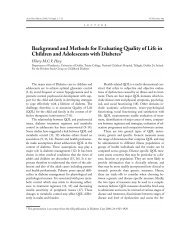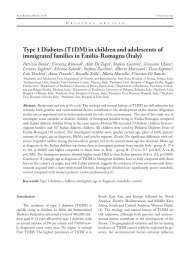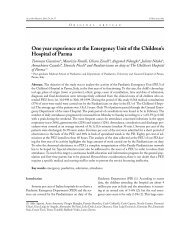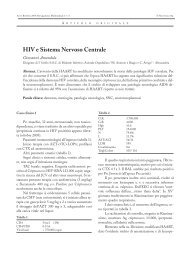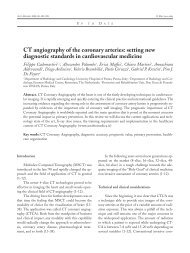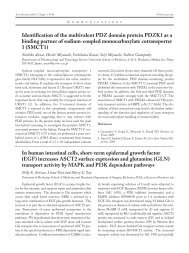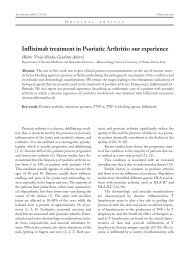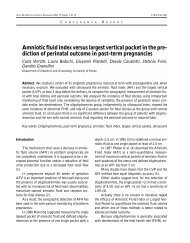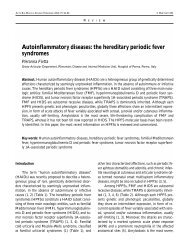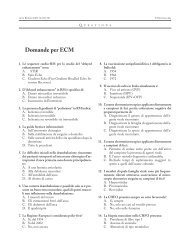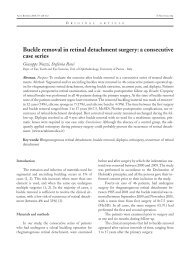Mattioli - Acta Bio Medica Atenei Parmensis
Mattioli - Acta Bio Medica Atenei Parmensis
Mattioli - Acta Bio Medica Atenei Parmensis
Create successful ePaper yourself
Turn your PDF publications into a flip-book with our unique Google optimized e-Paper software.
ACTA BIOMED 2006; 77; 33-39 © <strong>Mattioli</strong> 1885<br />
U P T O D A T E<br />
Self-centrality, psychosis and schizotaxia: a conceptual<br />
review<br />
Andrea Raballo 1, 2 , Eva Lundgren 2 , Emanuela Leuci 3 , Stefania Fontò 2 , Carlo Maggini 2<br />
1<br />
Psychiatric Intensive Care Unit, Department of Mental Health - AUSL Reggio Emilia; 2 Department of Neurosciences, Psychiatric<br />
Section, University of Parma, 3 Azienda Ospedaliera Desenzano D/G, Brescia<br />
Abstract. The phenomenon of self-centrality denotes a qualitative modification of the psychotic experience.<br />
Transitory experiences of self-reference have regularly been found in subjects in the prodromic phase and at<br />
the beginning of psychosis or in the post psychotic phase, and are specifically identified in the semeiotics of<br />
Basic Symptoms. However, self-centrality, in addition to being a morphological organizer in the psychotic<br />
crisis, also manifests itself in schizotypal personality disorders and in first-degree relatives of schizophrenics<br />
(where it is correlated to the degree of schizotypal traits). In these subjects, manifestations of self-centrality<br />
of a lesser intensity could be an indication of a latent vulnerability trait, which could modulate personal<br />
and psychopathological expressions of the schizotaxic diathesis. (www.actabiomedica.it)<br />
Key words: Self-centrality, subjective experience, beginning psychosis, schizophrenia spectrum, schizotaxia,<br />
vulnerability<br />
Introduction<br />
Autocentric-like experiences, which often include<br />
self-reference, have been described and contextualized<br />
in relation to the psychopathology of psychosis<br />
by Bleuler (Beziehungswahn) (1), and by Kretschmer<br />
(delusion of sensory relation, which brings about a<br />
“paranoid transformation of personal experience”) (2).<br />
Later, the same was done by Schneider who, along<br />
with Jaspers and Gruhle, pointed out that in the context<br />
of delusional perception the emergence of abnormal<br />
meaning occurs “generally in a sense of self-centrality”<br />
(3, 4). Next, Binswanger coined the prototypical<br />
notion of “being placed in the center” as a crucial<br />
turning point where the passage from a natural experience<br />
to a delusional one takes place (Ilse’s case) (5).<br />
Nevertheless, a description more specifically geared<br />
towards a characterization of the formal peculiarities<br />
of psychotic onset was originally put forth by Conrad,<br />
and later, in the French psychopathological literature,<br />
by Grivois.<br />
“Incoherence, polymorphism, loss of sense”, is the<br />
way that Sirere, Naudin and Grivois (6) sum up the<br />
clinical phenomena of the inaugural psychotic experience,<br />
stressing subjective experiences as a unifying<br />
factor. Among such subjective experiences, “centrality”<br />
could be a useful starting point when attempting to<br />
outline certain types of organizers which are part of<br />
the acute onset of psychosis.<br />
Accordingly, in Die beginnende Schizophrenie (7),<br />
Klaus Conrad outlines a detailed analysis of the phenomenological<br />
stages of the onset and development of<br />
psychotic consciousness, stressing the psychopathological<br />
importance of the gestaltic change in elemental<br />
ways of experiencing (8).<br />
In fact, Conrad points out that in the experience<br />
of the abnormal, attribution of meaning (apophany),<br />
and the consistent impression of being at the center of<br />
the “world” (anastrophe) are the “two elements characteristic<br />
of the structural mutation of the schizophrenic<br />
experience” and are “immediately and reciprocally<br />
related”. Anastrophe, in particular, would attest to
34 A. Raballo, E. Lundgren, E. Leuci, S. Fontò, C. Maggini<br />
“an extremely altered capacity to change systems of reference”,<br />
which results in a “loss of degrees of positional<br />
freedom”. The ability to “freely change reference<br />
systems” is, according to Conrad, the foundation of<br />
interpersonal attunement and hence represents the<br />
spontaneous ability of each person, albeit living in the<br />
center of his or her “world” to see themselves from<br />
“the outside”, “from above”, “from a bird’s eye view”,<br />
(and to) relate their own “world” to that general world<br />
of others” (7).<br />
“In his state of psychosis”, Conrad continues,<br />
“the schizophrenic has lost this possibility of transcendence<br />
…no matter what he looks at and no matter in<br />
what direction the arrow of his intent is aimed, that<br />
object “relates to him”.<br />
The impossibility to change perspective already<br />
comes to the surface in the Trema phase, where “the impossibility<br />
of transcendence is experienced as a barrier”<br />
and the entire psychic field is permeated with an imminent<br />
and undefinable state of alarm. This experience<br />
evolves into apophany (characterized by the total<br />
unfolding of the anthropological device of revelation)<br />
and into anastrophe (characterized by the slipping into<br />
a diffuse and impending erlebnis of self-reference), which<br />
may, however, subside if it does not crystallize and<br />
permit a return of the ability to decentralize oneself.<br />
According to Grivois (9), centrality (represented<br />
by an erroneous self-attribution of the intentions,<br />
judgments or behaviors of others) can be viewed as a<br />
clinical constant in beginning psychosis. The birth of<br />
psychosis resides in the crisis of interpersonal relationships<br />
which results in an abnormal conviction of being<br />
a focal point at the center of the world. “Centrality”,<br />
Grivois states, “is due to a collapse of subjectivity which<br />
derives from an insecurity in the relationship with<br />
others.” (10).<br />
At first, the experience is purely perceptive and<br />
mimetical, without any threatening significance, only<br />
to become a “specific emotion which intensifies” so<br />
that the most insignificant and marginal interactions<br />
and exchanges become signs that allude to the subject<br />
in question.<br />
Next, the process evolves into a general “alteration<br />
of interindividuality” (centralité) which modifies, “at times<br />
in a striking way”, the experience of being a man<br />
in a social context. “The individual feels as if he is at<br />
the center of reality to the point that everything that<br />
happens on a mundane level is related to him” (11).<br />
In a recent conceptual revision, Sirene, Grivois e<br />
Naudin (4, 6) have proposed an anthropophenomenological<br />
interpretation of centrality as a “fourth form of<br />
missing existence“ subsidiary to the triptych of Binswanger<br />
(“fixed exhilaration”, “eccentricity”, “mannerism”).<br />
The concept of centralité, in fact, constitutes a<br />
breach in the relationship between the amplitude of<br />
experience and the capacity to elaborate, which constitutes<br />
the anthropological proportion and provokes a<br />
profound spatial distortion of inter-personal orientation.<br />
It is the specific notion of centralité as a “forme de<br />
la Présence manquée” which accounts for its perseverance<br />
in the pre- (12-14) and post-psychotic phase<br />
(15-17), where the self-centered approach is the favored<br />
medium in “enduring earthly existence each time<br />
that the patient experiences a conflictual situation that<br />
he or she does not know how to manage” (18).<br />
Self-centrality and the Basic Symptoms Model 1<br />
The dynamic pathogenetic models of Huber<br />
(transitions between various Basic Symptoms) (19,<br />
20) and Klosterkoetter (serial connection) (21), within<br />
the context of “understanding” according to Jaspers,<br />
allow for a stimulating psychopathological revision of<br />
beginning psychosis. Within this conceptual framework,<br />
it is possible to redefine the self-centered experience<br />
into phenomenologically unitarian sequences.<br />
The latter guide the elaboration of overt productive<br />
symptoms and, contemporaneously, allow for a refined<br />
clinical discrimination between delusional selfcentrality<br />
(ie. apophanic Self-Centrality) and a more<br />
preliminary, subtle and elusive form, that is, subapophanic<br />
self-centrality, (16, 17) (in which the Copernican<br />
turning point can still be reached).<br />
1<br />
The concept of “Basic Symptoms” is clinically based on: basic<br />
experiences, uncharacteristic and aspecific, lived as a disturbance,<br />
and confined to the subjective sphere (19,20). Technically,<br />
Basic Symptoms indicate a personal perception of a deficit<br />
in drive, emotions, perception, interaction, thought, language,<br />
and planning activities, and can be qualified using the<br />
Bonn Scale for the Assessment of Basic Symptoms (22) [BSABS].
Self-Centrality, Psychosis and Schizotaxia<br />
35<br />
This basal self-centrality, which is included in the<br />
Bonn Scale for the Assessment of Basic Symptoms 2<br />
(22), denotes the fundamental precariousness of the<br />
ability to transcend on a primarily prereflective and<br />
protopathic level, and is probably due to the intervention<br />
of transphenomenic neurofunctional mechanisms<br />
(10, 11, 22, 23).<br />
Indeed, the self-centered experience is a paradigm<br />
of disturbed intersubjectivity which subsumes<br />
the preservation of the “ability to transcend” (Überstiegsfähigkeit)<br />
as a precondition for the intuitive establishment<br />
of “vital attunement” with the environment<br />
(24). In particular, if the psychotic condition also includes<br />
a pathology of intersubjective competence, the<br />
disturbance of the ability of attunement involved in<br />
self-centrality (especially when subapophanic in nature<br />
as described by the Basic Symptoms model), could<br />
be a psychopathological indicator of psychotic vulnerability<br />
and could modulate the course of the disease.<br />
Already in the “as if ” form, self-centrality reveals<br />
a state of surproximité (25) to the world which impedes<br />
the “ability to reside serenely among things” (26)<br />
and alludes to an underlying autistic vulnerability (27,<br />
28).<br />
Clinical evidence<br />
On the empirical level the relationship between<br />
self-centrality, anomalous subjective experiences<br />
(and/or Basic Symptoms), and psychosis has been examined<br />
using different experimental paradigms.<br />
Onset<br />
A ten-year prospective study (Cologne Early Recognition<br />
Project) performed on a group of subjects<br />
2<br />
The item C1.17 ”Subject-Zentrismus” of the BSABS, explicitely<br />
describes the “Centrality of the Subject” as an “experience<br />
of self-reference perceived and described by the patient who<br />
sees unimportant events, such as the behavior and comments<br />
of others, as being referred to him, even though he realizes at<br />
the same time (or immediately afterwards) that such an event<br />
is impossible or improbable. The patient has the feeling of<br />
being in the center of events without having a concrete or elaborated<br />
sense of such experience (22).<br />
treated in the clinical setting for putative prodromic<br />
symptoms has shown that certain Basic Symptoms,<br />
included in the subsyndrome “thought, perception,<br />
language and motility disturbances,” have a high positive<br />
predictive value in identifying individuals at increased<br />
risk of transition into schizophrenia (79 individuals<br />
out of 160 evaluated). Among these “highly<br />
predictive prodromal symptoms” (HPPS) transitory<br />
ideas of reference experienced in the “as if ” mode are<br />
also included (Item C1.17 of the BSABS: specificity,<br />
0.89; false positives, 5.6%) (29).<br />
More recently the same group performed a<br />
“short term follow-up” which confirms the positive<br />
predictive power of HPPS already after fifteen<br />
months (13, 14).<br />
In addition, the same research team has found<br />
that when comparing the anomalies of subjective experiences<br />
preceding the first schizophrenic and depressive<br />
episode, self-centrality is among the discriminatory<br />
Basic Symptoms (in addition to: feeling<br />
overwhelmed by sensory stimuli, disturbances in auditory<br />
perception, and disturbances in the ability to control<br />
non-verbal expression and affect), indicating that<br />
this combination of Basic Symptoms precedes the onset<br />
of the overt clinical episode by two to seven weeks<br />
(30).<br />
In accordance, the preliminary results of the<br />
EPOS (European Prediction of Psychosis Study)<br />
when analyzing the baseline symptomatology in a High<br />
Risk Sample in Amsterdam, have shown self-centrality<br />
to be present in over three fourths of the<br />
subjects studied (76%) (31).<br />
Postpsychotic phase<br />
Given a series of empirical indications derived<br />
from groups of subjects in the postpsychotic phase, it<br />
is possible to view self-centrality in a more relative<br />
way not only as an elective erlebnis at the onset (or in<br />
the immediate prodromic pre-psychosis), but also as<br />
an expansion of its psychopathological relevance to intercritical<br />
periods characterized by a relative stability<br />
of symptoms (15). In the postpsychotic phase patient,<br />
in fact, the discrimination between apophanic (i.e. delusional)<br />
and subapophanic Self-Centrality is appropriate<br />
in that it allows for the distinction between
36 A. Raballo, E. Lundgren, E. Leuci, S. Fontò, C. Maggini<br />
overt aspects of the psychotic experience, and more<br />
subtle qualitative changes in spatial perception which<br />
are not yet organized in a delusional sense (15, 16).<br />
Transitory impressions of self-reference “with an<br />
immediate ability to reactivate the Copernican turnover”<br />
are recognizable in over two thirds of schizophrenic<br />
subjects in psychotic remission (15). The presence<br />
of self-centrality is associated with a particular psychopathological<br />
profile: greater intensity of xenopathic<br />
content compared to other delusional themes<br />
and higher levels of basal-distress (16). In addition,<br />
self-centrality is strongly correlated to subjective experiences,<br />
such as alexithymia, depersonalization, and<br />
basic obsessions (15).<br />
A re-evaluation of the preliminary results in a wider<br />
sample has confirmed that of the three psychopathological<br />
constellations of greatest pertinence to<br />
sub-apophanic self-centrality (delusions of “controlpersecution”,<br />
alexithymic “difficulty identifying feelings”,<br />
and “abnormal body feelings”), the cenesthesic<br />
Basic Symptoms are those most highly predictive of<br />
its cooccurence (17).<br />
The importance of self-centrality in the characterization<br />
of schizophrenic self-experience is further validated<br />
by a comparative evaluation of Basic Symptoms<br />
in different diagnostic classes: subapophanic<br />
self-centrality increases the discriminative power of<br />
subjective experiential anomalies (32) (designated according<br />
to phenomenological criteria (33) to characterize<br />
core aspects of the schizophrenia spectrum 3 ). This<br />
is the case where affective disorders, as well as obsessive-compulsive<br />
disorders, are concerned indicating<br />
that a consideration of autocentric disturbances of intersubjectivity<br />
could be useful to understand the psychopathological<br />
experience of schizophrenia (17, 23,<br />
32).<br />
3<br />
Included in this reclassification of Basic Symptoms, we find<br />
seven subclassifications which are: Diminished affectivity (global<br />
deflection of affective potential), Disturbed contact (difficulties<br />
and subjective embarassment in social and interpersonal<br />
relationships), Perplexity (altered articulation and intuitive interpretation<br />
of meanings), Cognitive disorder (a reduced flow in<br />
cognitive processes), Self-disorder (a disorder in the experiences<br />
of self ), Coenesthesias (disorders in bodily experiences) and<br />
Perceptual disorder (perceptive distorsions) (33).<br />
Schizotaxic vulnerability<br />
The phenomenon of self-centrality also manifests<br />
itself in subjects with schizotypal personality disorder<br />
and in first-degree relatives of schizophrenics 4 . This<br />
population has a high schizotaxic risk (34-36) and presents<br />
(as has also been found on a neurocognitive and<br />
personality level) a profile of anomalies of subjective<br />
experience which can be collocated midway between<br />
the general population and the conditions typical of<br />
the clinical spectrum (36, 37), with a particular reference<br />
to cognitive and cenesthesic Basic Symptoms<br />
(34). The correlation between such symptoms and the<br />
intensity of schizotypal traits (38) seems to suggest<br />
that an altered experience of physicality and cognitive<br />
proficiency constitute the psychological correlate (35)<br />
of the dimensions of schizotypy (39). Further, it has<br />
been found that sub-apophanic self-centrality is correlated<br />
both to cognitive-perceptual as well as to interpersonal<br />
factors of schizotypy, thus representing a shared<br />
experiential background for both (23).<br />
Additional research, above all in developmental<br />
psychopathology, is necessary to ascertain whether the<br />
predisposition to self-centrality is a prerequisite for<br />
the development of positive and negative traits of the<br />
schizotypy, or whether it is a consequence. However,<br />
it seems plausible (considering the Basic Symptoms<br />
Model (19,20) and the theory of Meehl (35)) that a<br />
common schizotaxic vulnerability provokes a transphenomenological<br />
liability in the intersubjective space.<br />
The latter reverberates on the level of personality in<br />
the interpersonal and cognitive-perceptive dimensions<br />
of the schizotypy, as well as in the experiential one of<br />
transitory experiences of self-reference (23, 37).<br />
Clinical, therapeutic, and diagnostic implications<br />
A careful consideration of the phenomenon of<br />
“central polarization”, both in its more subtle form (“as<br />
4<br />
The cross-sectional “as if ” self-centrality in recently evaluated<br />
samples (34), analyzed in the out-patient clinic of the Psychicatric<br />
Section of the Neurosciences Department of the University<br />
of Parma has shown: control groups [
Self-Centrality, Psychosis and Schizotaxia<br />
37<br />
if ”) and in the overt form, has important clinical consequences<br />
in that it allows for a prediction of the susceptibility<br />
to schizophrenia and psychotic relapse,<br />
thus making possible the formulation of an adequate<br />
observational and therapeutic protocol.<br />
Psychotherapeutic, educational, and psychopharmacological<br />
intervention on Basic Symptoms can arrest<br />
their transition to psychotic symptoms, thus facilitating<br />
the return to less persistent and disturbing<br />
symptoms (first level Basic Symptoms) and avoiding a<br />
stable and autonomous psychosis (20, 21). In this context,<br />
in order to maximize the patient’s coping skills,<br />
the analysis of the experience of self-centrality is a<br />
priority.<br />
On this topic, Grivois and Grosso stress the importance<br />
of a “clinical-relational” approach when treating<br />
beginning psychosis. The doctor and the patient<br />
find themselves auspicably “sharing a perspective of<br />
common intelligence regarding the event. The clinician<br />
attempts to reconstruct ...the development of the<br />
episode in progress starting from its recent interpersonal<br />
roots without introducing simplistic notions of<br />
causality”, and without undertaking a hurried and reductive<br />
“search for meaning in the past”, but rather<br />
“modestly attempts to address that which most defines<br />
the acute state of suffering of the patient” (11).<br />
Aside from helping the patient to verbalize an experience<br />
which would otherwise be a source of tremendous<br />
anguish, this model has implications on a<br />
rehabilitative level, in that it permits the recognition<br />
of a specific dominion of interpersonal vulnerability<br />
which, if not alleviated in a timely fashion, represents<br />
a potential interference both in the therapeutic relationship<br />
and in the social integration of the patient.<br />
In this context, a perturbation of the elementary<br />
mechanisms which regulate relationships of interpersonal<br />
coordination (11) could constitute the transphenomenologial<br />
primum movens of concernement, which<br />
becomes transformed into a disturbance in interpersonal<br />
relationships and experiences expressed on a behavioral<br />
level as a predisposition to social withdrawal.<br />
The latter, which is also found in schizotaxic individuals<br />
in terms of a social aversiveness trait, could be<br />
influenced by a greater proneness to transitory disturbances<br />
of central polarity 5 (23).<br />
Thus, the psychopathological analysis of experiences<br />
of self-centrality is promising both in terms of<br />
a clinical-therapeutic perspective and in terms of research.<br />
Elusive disturbances of interpersonal space are<br />
in fact, today, insufficiently characterized by notions of<br />
“altered interpersonal contact” which primarily focus<br />
on minus-asthenic aspects of the interpersonal deficit,<br />
neglecting the potential effect of experiences such as<br />
self-reference, that are more indicative of a relative<br />
“incapacity to keep the world at a distance” (18). In<br />
this perspective, self-centrality is a recognizable experiential<br />
phenotype, which is particularly suggestive<br />
when attempting to elaborate an empirical approach<br />
subsidiary to the renascent interest in the phenomenon<br />
of loss of social competence in the schizophrenic<br />
spectrum (40, 41), as well as autistic vulnerability in<br />
schizotaxic individuals (23, 27, 28).<br />
Acknowledgements<br />
Preparation of this manuscript was supported in part by<br />
the Istituto Ospedaliero di Sospiro di Cremona, grant on the<br />
topic “Esordio della schizofrenia”, to Dr. Raballo.<br />
Conclusions<br />
Self-centrality (SC) is an emblematic characteristic<br />
of the experience of beginning and post-psychosis.<br />
These experiences, which are specifically addressed in<br />
the semeiotics of Basic Symptoms, recall the original<br />
notion of Conrad of “loss of degrees of freedom” as a<br />
prelude to the “psychotic change in experience” and<br />
are associated with discenesthetic anomalies in the experience<br />
of the lived body (17).<br />
5<br />
As Grivois and Grosso specify, (11) “the influence of its minor<br />
forms is a normal experience, common to all men when it<br />
touches them” and ephemeral changes in its involvement can<br />
appear even in unexpected social situations, or can be particularly<br />
applicable to anxious or phobic individuals”. In any event,<br />
the amplification and the persistence of concernement that becomes<br />
“irresistibly invasive” and unavoidable seems to mark<br />
the global qualitative transformation of the experience that signs<br />
the beginning of psychosis and is traceable, albeit in a more<br />
elusive and subtle sense, to subtle derailments of the Uberstiegsfähigkeit<br />
even in relatives of schizophrenics.
38 A. Raballo, E. Lundgren, E. Leuci, S. Fontò, C. Maggini<br />
References<br />
1. Bleuler E. Dementia praecox oder Die Gruppe der Schizophrenien.<br />
In: Aschaffenburg G (ed). Handbuch der Psychiatrie.<br />
Leipzig-Wien: Deuticke, 1911.<br />
2. Jaspers K. Allgemeine Psychopathologie. Berlin: Springer-<br />
Verlag, 1913.<br />
3. Schneider K. Klinische Psychopathologie. Stugartt: Thieme,<br />
1960.<br />
4. Gozzetti G, Sava V. La nascita della psicosi in adolescenza.<br />
Una Introduzione Critica e Epistemologica, con divagazioni.<br />
Congresso Nazionale: “Trasgressione, Crescita, Identità”.<br />
Cosenza, 1-2 giugno 2001.<br />
5. Binswanger L. Wahnsinn als lebensgeschichtliches Phaenomen<br />
und als Geisteskrankheit. Der fall Ilse (1945), in<br />
“Schizophrenie“, Neske: Pfullingen, 1957.<br />
6. Sirere S, Naudin J, Grivois H. La centralité comme mode<br />
de présence spécifique de l’expérience psychotique inaugurale.<br />
Ann Méd Psychol 1999; 157: 636-63.<br />
7. Conrad K. Die beginnende Schizophrenie. Versuch einer<br />
Gestaltanalyse des Wahns. Stuttgart: Thieme, 1958.<br />
8. Gozzetti G, Cappellari L, Ballerini A. Psicopatologia fenomenologica<br />
della psicosi. Milano: Raffaello Cortina Editore,<br />
1999.<br />
9. Grivois L. Le Fou et le Mouvement du Monde. Paris: Éditions<br />
Grasset et Fasquelle, 1995.<br />
10. Grivois H. De l’individuel à l’universel: La centralité psychotique.<br />
In: Dupuy JP, Grivois H (ed): Mécanismes mentaux,<br />
mécanismes sociaux: De la psychose à la panique. Paris:<br />
Éditions La découverte, 1995.<br />
11. Grivois H, Grosso L. La schizophrénie débutante. Paris:<br />
Edition John Libbey Eurotext, 1998.<br />
12. Klosterkotter J, Hellmich M, Schultze-Lutter F. Is the diagnosis<br />
of schizophrenic illness possible in the initial prodromal<br />
phase to the first psychotic manifestation? Fortschr<br />
Neurol Psychiatr 2000; 68 Suppl 1: S13-21.<br />
13. Hambrecht M, Lammertink M, Klosterkotter J, Matuschek<br />
E, Pukrop R: Subjective and objective neuropsychological<br />
abnormalities in a psychosis prodrome clinic. Br J<br />
Psychiatry 2002; Suppl 43: s30-7.<br />
14. Ruhrmann S, Schultze-Lutter F, Klosterkotter J. Early detection<br />
and intervention in the initial prodromal phase of<br />
schizophrenia. Pharmacopsychiatry 2003; Suppl 3: S162-7.<br />
15. Raballo A, Maggini C. Autocentralità, delirio e sintomi di<br />
base nella schizofrenia cronica. III Congresso Nazionale<br />
della Società Italiana per la Psicopatologia: “Fenomenologia,<br />
Psicopatologia e Terapia”. Firenze, 30 Novembre 2002.<br />
16. Maggini C, Raballo A. Self-Centrality and delusions in<br />
schizophrenia. Neurol Psych Brain Res 2002; 10: 67-74.<br />
17. Maggini C, Raballo A. Self-Centrality, Basic Symptoms<br />
Model and Psychopathology in Schizophrenia. Psychopathology<br />
2004; 37: 69-75.<br />
18. Cappellari L. Sul concetto di “anastrophé”. Psich Gen Età<br />
Evolutiva 2003; 3: 221-229.<br />
19. Huber G. Das Konzept substratnaher Basissymptome und<br />
seine Bedeutung für Theorie und Therapie schizophrener<br />
Erkrankungen. Nervenarzt 1983; 54: 23-32.<br />
20. Huber G, Gross G. The concept of basic symptoms and basic<br />
stages and its meaning for schizophrenia and schizoaffective<br />
psychoses. In: Maggini C (ed): Psicopatologia e Clinica<br />
della Schizofrenia, pp 41-58. Pisa: ETS, 1995.<br />
21. Klosterkoetter J. The development of Schneiderian first<br />
rank symptoms. In: Maggini C (ed) Psicopatologia e Clinica<br />
della Schizofrenia. Pisa: ETS, 1995, 75-115.<br />
22. Gross G, Huber G, Klosterkoetter J, Linz M. BSABS.<br />
Bonner Skala fur die Beurteilung von Basissymptomen<br />
(Bonn Scale for the Assessment of Basic Symptoms). Berlin:<br />
Springer, 1987; Trad. Ital. a cura di Maggini C, Dalle<br />
Luche R: Scala di Bonn per la valutazione dei sintomi di<br />
base. Pisa: ETS, 1992.<br />
23. Raballo A, Maggini C. Personality and psychosis: Subjective<br />
experiences, self-centrality and schizotypal dimensions<br />
in 1st degree relatives of schizophrenics. European Psychiatry<br />
2004; 19 Suppl 1: 49s.<br />
24. Minkowski E. La notion deperte de contact vital avec la<br />
réalité et ses applications en psychopathologie. Paris: Jouve<br />
& Cie, 1926.<br />
25. Tatossian A. Phénoménologie des Psychoses. Paris: Masson,<br />
1979.<br />
26. Binswanger L. Being-In-The-World: Selected Papers. Ed<br />
and translated by Needleman J. New York: Basic Books,<br />
1963.<br />
27. Ballerini A. Autismo e schizofrenie paucisintomatiche. Psichiatria<br />
Oggi 2002; 2: 6-13.<br />
28. Ballerini A. Patologia di un eremitaggio. Uno studio sull’autismo<br />
schizofrenico. Torino: Bollati Boringhieri, 2001.<br />
29. Klosterkotter J, Hellmich M, Steinmeyer EM, Schultze-<br />
Lutter F. Diagnosing schizophrenia in the initial prodromal<br />
phase. Arch Gen Psychiatry 2001; 58: 158-64.<br />
30. Bechdolf A, Schultze-Lutter F, Klosterkotter J. Self-experienced<br />
vulnerability, prodromal symptoms and coping strategies<br />
preceding schizophrenic and depressive relapses. European<br />
Psychiatry 2002; 17: 384-93.<br />
31. Van de Fliert JR, Becker HR, Linszen DH, et al. Patients<br />
at high risk for psychosis: Baseline symptomatology. European<br />
Psychiatry 2004; 19 Suppl 1: 36s.<br />
32. Raballo A, Maggini C. Anomalies of subjective experiences<br />
in schizophrenia, affective disorder and obsessive-compulsive<br />
disorder. European Psychiatry 2004; 19 Suppl 1: 16s-<br />
17s.<br />
33. Parnas J, Handest P, Sæbye D, Jansson L. Anomalies of<br />
subjective experience in schizophrenia and psychotic bipolar<br />
illness. <strong>Acta</strong> Psychiatr Scand 2003; 108: 126–33.<br />
34. Maggini C, Raballo A. Subjective experience of schizotropic<br />
vulnerability in siblings of schizophrenics. Psychopathology<br />
2004; 37: 23-8.<br />
35. Meehl P. Schizotaxia revisited. Arch Gen Psychiatry 1989;<br />
46: 935-44.<br />
36. Tsuang MT, Stone WS, Tarbox SI, Faraone SV. An integration<br />
of schizophrenia with schizotypy: identification of<br />
schizotaxia and implications for research on treatment and<br />
prevention. Schizophr Res 2002; 54: 169-75.<br />
37. Wieneke A, Schultze-Lutter F, Steinmeyer EM, Klosterkotter<br />
J. Abnormal subjective experiences and neuro-
Self-Centrality, Psychosis and Schizotaxia<br />
39<br />
psychological deficits in first-degree relatives of schizophrenics.<br />
Schizophr Res 1997; 24: 49s.<br />
38. Maggini C, Raballo A. Subjective experience of personality<br />
dimensions in 1st degree relatives of schizophrenics. <strong>Acta</strong><br />
<strong>Bio</strong>med Ateneo Parmense 2003; 74: 131-6.<br />
39. Raine A, Reynolds C, Lencz T, Scerbo A, Triphon N, Kim<br />
D. Cognitive–perceptual, interpersonal, and disorganized<br />
features of schizotypal personality. Schizophr Bull 1994; 20:<br />
191-201.<br />
40. Maj M. Critique of the DSM-IV operational diagnostic<br />
criteria for schizophrenia. Br J Psychiatry 1998; 172: 458-<br />
60.<br />
41. Raballo A, Maggini C. Experiential anomalies and Self-<br />
Centrality in Schizophrenia. Psychopathology 2005, in press.<br />
Accepted: 5 January 2006<br />
Correspondence: Prof. Carlo Maggini<br />
Department of Neurosciences, Psychiatric Section,<br />
University of Parma<br />
P.le Matteotti, 43100 Parma, Italy<br />
Fax +39 0521 230611<br />
Tel +39 0521 206561<br />
E-mail:carlo.maggini@unipr.it



